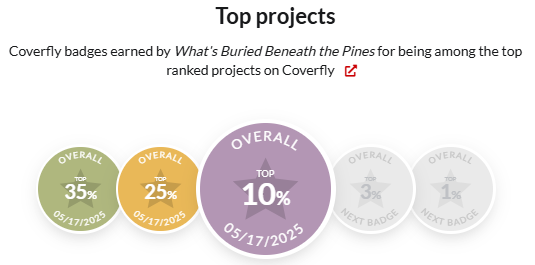Some news worth sharing: What’s Buried Beneath the Pines is now ranked in the top 9% of all projects on Coverfly.
For those unfamiliar, Coverfly is one of the leading platforms in the screenwriting space—used by reps, execs, and industry readers to scout unrepresented talent and track standout scripts across major competitions. And when they say “top 9%,” they mean out of tens of thousands of projects from around the world. That’s a serious cut. This isn’t a random number. It’s a real-time, data-driven placement based on a script’s performance across contests, reader scores, and industry evaluations. So this means something. It means consistency. It means momentum.
This isn’t a placement tied to one contest or a temporary bump. This is an aggregate score based on consistent performance, strong coverage, and a script that keeps showing up across multiple reads, competitions, and evaluations. It’s the kind of signal that says: this story has legs.
What’s Buried Beneath the Pines isn’t a flashy concept. It’s not built on explosions or high-concept hooks. It’s a slow-burn Southern Gothic pilot rooted in grief, blood, legacy, and land. It follows Gray Harris, the reluctant heir to a timber empire, who returns home to bury his father and winds up unearthing a legacy soaked in secrets, shame, and violence that’s been festering beneath the surface for decades. The tone is quiet but cutting. The tension is emotional, not explosive. And the drama unfolds in glances, in silences, in the space between what’s said and what’s buried.
It’s not an easy sell. And it’s not meant to be. This script was written for people who know what it feels like to grow up in a house where the silence says more than the words. For people who understand how tightly small towns cling to reputation—and how violently they resist the truth.
To be sitting in the top 9% of all Coverfly projects tells me this thing is resonating. Not just with one set of readers or in one context, but across the board. It’s competing in the marketplace of stories—and holding its own. Every time it lands in front of someone new, it makes an impression. It lingers.
WBBTP is also the pilot for an anthology series called Revenance. Each season would peel back the layers of a different rural American family, each with their own ghosts, grudges, and generational sins. But it starts here—with Gray. With his father. With the weight of the land. Think True Detective meets Sharp Objects, but rooted even deeper in rural tension and generational reckoning. This isn’t about solving a mystery—it’s about surviving one.
In the last few months, this script has landed in the quarterfinals of the Script Pipeline TV Writing Competition, the Nashville Film Festival, and Roadmap Writers’ JumpStart Competition. That’s not a brag—it’s a pattern. And this Coverfly milestone adds fuel to the fire. The dots are starting to connect.
The reality is: writing is long. The wins are small. But they build. Every nod, every note, every percentile bump means one more person saw something worth championing. And sometimes, that’s all it takes to crack open the next door.
I’ve spent years building this project—through revisions, feedback, rewrites, more rewrites, and plenty of near-give-ups. So to have it not only survive but rise on a platform like Coverfly is the kind of slow win that actually matters. It’s the kind of thing you look back on and realize: yeah, that’s when it started to change.
Huge thanks to everyone who’s read this script, supported my work, offered feedback, or simply shared it with someone who needed to see it. This thing is moving. Slowly, steadily, and in the right direction. It’s becoming undeniable.
Here’s to the next climb. Onward.





